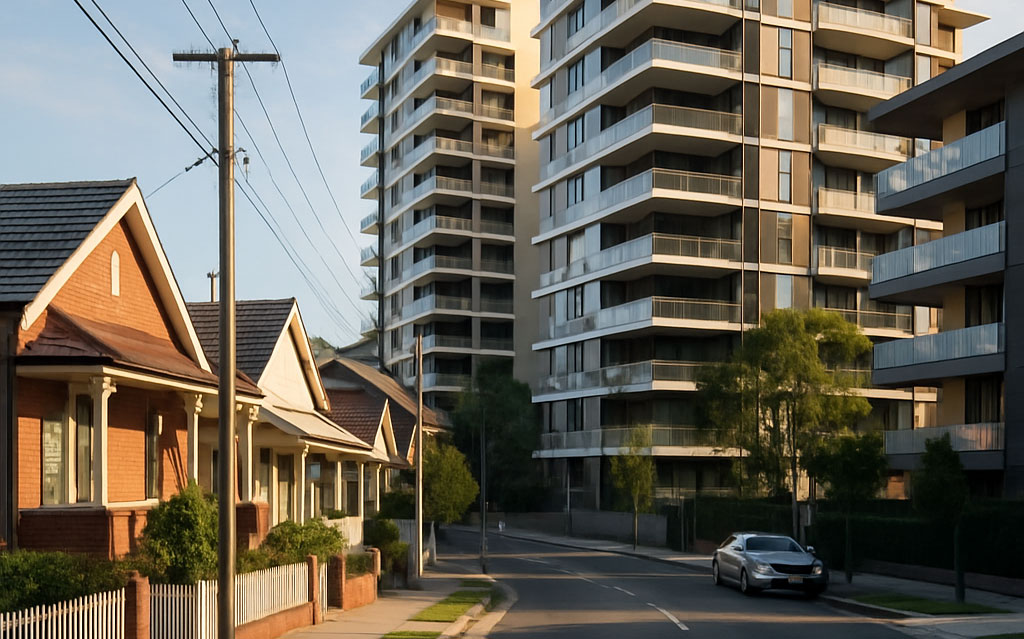This cut changes borrowing power and auction dynamics. Here’s what to adjust this week.
Updated for the Reserve Bank of Australia’s 25-basis-point cut on 12 August 2025, which lowered the cash rate to 3.60%.
Sydney families and first-home buyers have just been handed some long-awaited relief. After keeping rates on hold in July, the RBA trimmed the cash rate by another 0.25 percentage points to 3.60%, citing continued progress on inflation and a softer labour market. Major lenders have begun (or announced plans) to pass the cut through to variable mortgage customers, though some have flagged a short lag before the savings hit accounts.
On the surface, this is good news: lower rates reduce borrowing costs and can lift your borrowing capacity. But Sydney’s housing market is uniquely tight. Chronic undersupply, population growth, and very high starting prices mean that rate cuts can also re-ignite competition and push prices higher, particularly in the city’s most interest-rate-sensitive segments. Analysts across the major outlets have already warned of this “double-edged sword.”
Below, we unpack what this cut means for you, right now, over the next 6–12 months, and in the longer run, and how to make savvy, low-stress decisions if you’re buying in Sydney.

5 Quick Points for Sydney Buyers
- Your monthly repayments should fall (a bit). Once lenders apply the reduction, a typical Sydney mortgage will be slightly cheaper; some banks are already moving, others in coming days.
- Borrowing power will tick up, but so will competition at opens and auctions, especially for quality family homes near schools and transport.
- Short-term price support is likely in Sydney as confidence returns; even modest cuts historically lift demand in rate-sensitive markets.
- Listings could stay tight as would-be sellers try to time the market, keeping upward pressure on prices.
- First-home buyers should plan proactively (and defensively): get pre-approval early, set walk-away limits, and consider flexible locations or property types to avoid being outgunned by investors and upgraders.
What the cut is, and isn’t
The RBA’s August decision takes the cash rate to 3.60%, the third reduction in six months and the first time rates have been sustainably under 4% since 2023. Markets and major banks had widely expected a 25-point move. The ASX rallied to a record close on the day, highlighting improved risk sentiment.
“The Reserve Bank board has delivered an interest rate cut of 25 basis points, taking the cash rate to 3.6 per cent and bringing relief for home loan borrowers.”
Banks are starting to pass the cut on, though most borrowers won’t see the lower repayment until their lender’s effective date. For a $750,000 loan, media estimates suggest a saving of roughly $100–$110 per month once the cut fully flows through—useful, but not market-transforming on its own.
Why rate cuts tend to lift property prices (especially in Sydney)
Economists and housing researchers consistently find that interest rates are the dominant short-run driver of dwelling prices when housing supply can’t respond quickly. ABC’s analysis, synthesising bank models, notes that a 100-basis-point easing is associated with roughly a 9% rise in home prices over time; with cuts in February, May and August totalling 75 points so far, and another move possible later this year, the direction of travel is clear.
“100 basis points of interest-rate cuts could see home prices rise by 9 per cent.”
Sydney is particularly rate-sensitive. Recent auction outcomes show buyers stepped up almost immediately following earlier cuts this year, with standout results coming through just days after lenders moved.
REA Group observed that “interest rate cuts triggered big spending from home buyers at Sydney auctions,” with some results hundreds of thousands above expectations.
Domain’s price-forecasting work (as reported in mainstream outlets) also flags Sydney and Melbourne as the cities most likely to see price leadership as rates grind lower, given their sensitivity to borrowing costs and entrenched demand.
The short term (0–6 months): what to expect in Sydney
1) Modest repayment relief, phased in by lenders
Most mortgage customers will see their rate fall once their bank’s effective date hits. Some lenders pass cuts quickly; others lag a week or two. Keep an eye on your lender’s notifications and statements and consider a health check/refinance if you’re still far above the best-in-market variable rates.
2) A “confidence pop” at opens and auctions
Lower rates boost buyer morale and pre-approval amounts, bringing sidelined participants back. This is already feeding through: agents reported stronger bidding immediately after prior cuts this year. Expect more competitive Saturday auctions and fewer vendor discounts, especially for well-located family homes near schools and trains/light rail.
3) Listings remain tight, so FOMO risk rises
PropTrack data highlighted a slowdown in new Sydney listings as many owners waited on the RBA. If the pipeline drips back gradually, supply will stay scarce relative to demand, amplifying price support in the near term and making it harder for buyers who “wait for more stock.”
4) First-home buyers face a double-edged sword
Lower rates lift borrowing power but also awaken investors and upgraders who can outbid with larger deposits. REA and other commentators have repeatedly warned that rate-cut rallies can paradoxically worsen affordability for First Home Buyers by nudging prices up faster than repayments fall.
5) Media and bank signals reinforce momentum
Mainstream coverage points to renewed demand and future cuts being plausible if inflation keeps easing. Markets are primed for more easing this year, a backdrop that tends to reinforce buyer confidence.
Bottom line (0–6 months): Repayments dip a little; competition rises a lot. Be auction-ready.
The medium term (6–18 months): the “tempo” of the market
1) Prices: steady-to-firm with rate-sensitive leadership
With the cash rate now below 4%, and another move possible later in 2025, Sydney could see continued price growth, albeit not at the “stratospheric” pace of the pandemic boom. The combination of lower borrowing costs and structural undersupply supports the base case for further moderate gains.
2) Composition of demand: investors vs. first-home buyers
Lower rates can tilt the field back towards investors, particularly in middle-ring suburbs with strong rental demand. Multiple outlets flagged this risk earlier in the year; it remains relevant after the latest cut. Families and First Home Buyers should plan for more multi-bidder scenarios on A-grade listings.
3) Supply response: slow and patchy
Even with better financing conditions, new supply won’t arrive overnight. Construction pipelines face capacity and cost constraints; policy moves to accelerate approvals will take time to bite. The result: ongoing competition for established homes, particularly those within school catchments and near fast transport.
4) Lending conditions and refinancing churn
Media and industry trackers are reporting renewed refinancing activity and lender competition, which should support borrowing power at the margins. Smart households will use savings from cuts to maintain higher repayments, reducing principal faster to protect against future shocks.
5) Rents: still tight, but growth may cool from peaks
Investors’ return can add rental stock at the margin, but population inflows and low vacancy mean rental markets remain tight. Buyers moving from rent to ownership may feel relief; others could face ongoing rent inflation, albeit slower than the breakneck pace of 2023–24. (AFR and ABC coverage emphasise the structural supply challenge.)
Bottom line (6–18 months): Expect moderate price growth, persistent competition for quality stock, and only a gradual improvement in choice.
The long term (18+ months): rates, productivity, and affordability
The RBA’s own statements and AFR coverage remind us that Australia’s trend growth and productivity dynamics will shape how far and how fast rates can fall. Even as inflation cools, the Bank is wary of cutting into a setting that stokes excess demand. That means the long-run destination could be a cash rate still above the pre-pandemic lows, limiting how far borrowing costs ultimately fall.
AFR summarised the caution succinctly, noting the RBA’s warning that the economy may be unable to grow faster than ~2% without generating inflationary pressure, a structural speed limit that tempers euphoria.
For Sydney, that implies enduring affordability challenges: population growth, high construction costs, planning bottlenecks, and a price base already at world-city levels. Rate cuts help, but they’re not a cure-all. Over the longer horizon, buyers gain most by focusing on value-drivers: school zones, commute times, liveability, and future infrastructure, rather than chasing speculative appreciation.
Bottom line (18+ months): Rates may trend lower than 2023–24 highs, but structural constraints mean Sydney affordability remains tight. The winners will be buyers who prioritise enduring fundamentals over short-term buzz.
What this means practically for Sydney families & first-home buyers
1) Get your finance bullet-proof
- Refresh your pre-approval immediately after the cut; some banks will lift maximum borrowing limits.
- Stress-test repayments at at least 1–1.5% above your expected rate so you’re resilient if lenders’ discounts change.
- If your lender is slow to pass on the cut, consider refinancing while competition is hot. Media reports suggest sizeable savings if you maintain pre-cut repayment levels after the reduction.
2) Choose your battles
- Expect hotter auctions for renovated family homes near selective schools, metro/rail, and village high streets.
- Expand your search radius one or two train stops beyond your ideal suburb; similar amenity, less competition.
3) Tactics for low-stress buying in a rising market
- Attend three to five comparable auctions before you bid to calibrate.
- Ask for price-guide evidence (recent sales, adjustments post-interest-rate cut).
- Use walk-away points: pre-commit to exits at $X and $X + $5–10k; tell your bidder to stop at the second number.
- Where competition is fierce, consider pre-auction offers anchored to recent, post-cut results.
4) Consider apartments and townhouses
Apartment and townhouse segments, especially in established, low-rise blocks near transport, can lag houses on the way up offering better value-per-square-metre for First Home Buyers. Be thorough on building reports and strata health.
5) Timing and psychology
After a rate cut, weeks 1–6 often see a burst of activity as buyer sentiment rebounds. If your budget is tight, either strike early with crisp terms or wait out the initial FOMO and shop more strategically as fresh listings drip on.
Pull-quotes & what the big outlets are saying
“The Reserve Bank… cut interest rates to 3.6 per cent… bringing relief for home loan borrowers after July’s unexpected ‘on hold’ decision.” (ABC)
“100 basis points of interest-rate cuts could see home prices rise by 9 per cent.” (ABC)
“Interest rate cuts triggered big spending from home buyers at Sydney auctions.” (realestate.com.au)
“The latest interest rate cut could make life harder for first-home buyers as investors and upgraders return.” (realestate.com.au)
“The RBA warned the economy may be incapable of growing faster than 2% without inflation pressure.” (AFR)
CoreLogic modelling suggests some markets could see the largest value change from a 1-percentage-point reduction in the cash rate—reinforcing that cuts often lift prices the most in rate-sensitive pockets. (CoreLogic)
Suburb-level dynamics to watch in Sydney
- Inner West & Lower North Shore: Premium, school-adjacent stock remains fiercely contested. Small rate moves reignite upsizer chains, supporting prices.
- South-west & outer west: Family buyers hunting backyards balance commute trade-offs against price; scope for value if you’re flexible on travel times.
- Eastern Suburbs units: Older low-rise blocks near light rail or train stations offer comparatively accessible entry points; strata diligence is crucial.
- Growth corridors: New-build supply remains constrained by builder capacity and costs; land releases and turnkey homes can face longer delivery timelines.
- Lifestyle/coastal within 10–20km: Amenity-rich pockets keep price stickiness; seek out streets with inferior aspect or homes needing cosmetic upgrades for a foothold.
Risks & counter-currents to keep on your radar
- Lagged pass-through: If your bank delays applying the cut (some can take ~two weeks), your near-term cash-flow relief may be slower than headlines suggest.
- Macro caution at the RBA: Weak productivity and slow trend growth could cap how far and how fast rates fall from here.
- Investor resurgence: Lower rates & tight rentals may draw investors back, intensifying competition exactly where First Home Buyers are shopping.
- Supply inertia: Planning reform and construction capacity are slow-moving ships; structural undersupply keeps pressure under prices even as rates ease.
Strategy playbook for different buyer profiles
First Home buyers (FHBs)
- Pre-approval early, valuation-ready: Ensure your lender’s valuation reflects current post-cut comparable sales.
- Consider “neighbourhood adjacencies”: If your target suburb is overcooked, look one or two train stations beyond, or an adjacent school catchment with similar results.
- Conditional flexibility: Shorter finance clauses and readiness to exchange can beat a marginally higher price.
- Apartment due diligence: Building report, strata records, capital works history; target low-rise, good aspect, sound sinking fund.
Families/Upsizers
- Chain management: If selling and buying, use the renewed confidence to sequence: firm up your sale strategy with contingency timelines, then buy with clear walk-away limits.
- School-zone heat: Expect tight, aggressive auctions around high-performing catchments; consider near-zone streets with similar transport/park access.
- Renovation scope: If renovation capacity is limited city-wide, a move-in ready home can justify a premium, but scrappy cosmetic jobs may offer instant equity if priced right.
FAQs
1) How much extra can I borrow after the 0.25% cut?
It depends on your income, expenses and lender buffers, but many households see a small increase in borrowing capacity. Treat it as bonus headroom, not a reason to stretch—competition will also intensify, especially in Sydney.
2) Will Sydney prices jump immediately?
We’ve already seen faster bidding following earlier cuts this year, with standout auction results within days. Expect firmer prices where stock is scarce, though large city-wide spikes are less likely than selective heat in A-grade pockets.
3) Should I rush to buy now before the next cut?
Not necessarily. Rate cuts can lift prices over time but overpaying because of FOMO can erase the benefit. Focus on value, be auction-ready, and pick your moment, either strike early with crisp terms or wait past the initial surge in competition.
4) My bank hasn’t reduced my rate yet—is that normal?
Yes. Most banks delay implementation: estimates suggest up to two weeks for many. If yours drags its feet, consider refinancing or negotiating.
5) Are first-home buyers better or worse off now?
Both. Repayments are lower and borrowing capacity is better, but competition from investors and upgraders can crowd First Home Buyers out of prime stock. This is why discipline and suburb flexibility are critical for First Home Buyers in Sydney.
How a Buyers’ Agent Adds Real-World Value (Especially Now)
In a rate-cut environment, speed, information, and execution separate successful buyers from frustrated under-bidders. A seasoned Sydney Buyers Agent can:
- Read the micro-market: We see which streets and school-zone borders are heating first after the cut, and where value still exists a station or two away.
- Source off-markets and pre-markets: In tight listing cycles, off-market access can reduce competition and give you a calmer negotiation runway.
- Price with precision: We adjust comps to reflect post-cut conditions (not last quarter’s medians), so your offers are strong but not wasteful.
- Negotiate smarter terms: Shorter finance/settlement windows, early building-and-pest, and escalation structures that win without overreach.
- Protect you from FOMO: Clear walk-away rules, bid discipline, and independent advice—so you don’t “win” the wrong home at the wrong price.
With rates drifting down but supply still tight, the margin for error shrinks. Expert guidance can save you months of searching, thousands at auction, and countless sleepless nights.
Conclusion
The RBA’s August 2025 cut to 3.60% is welcome relief and a psychological turning point. For Sydney, it likely means stronger competition, tighter listings, and selective price gains in the near term, especially for quality family homes and well-located apartments. Over 6–18 months, the market’s tempo should remain steady-to-firm as lower rates meet slow-moving supply. In the long run, affordability will still be tested by structural constraints—even if rates edge lower from here.
For families and first-home buyers, success now hinges on planning and precision: robust finance, disciplined bidding, and smart suburb selection. If you want help navigating the next few months with confidence (and calm), a specialist Sydney buyers’ agent can turn a complex market into a clear plan.
Sources & further reading
- RBA decision & market reaction: ABC live markets blog (cash rate to 3.6%, ASX record close). ABC
- Banks passing on cuts / timing: Guardian & major-bank updates; lender pass-through delays for borrowers. The Guardian
- Rate cuts and price dynamics: ABC explainer (modelled 9% rise per 100bp cut). ABC
- REA (realestate.com.au) auction and FHB commentary: Immediate Sydney auction boost; investor resurgence risk; FHB challenges post-cut. Realestate
- CoreLogic research on rate-sensitivity across regions: “Which housing markets could get the biggest boost from rate cuts?” (technical note). CoreLogic
- AFR on macro caution/productivity: RBA’s warning on slower trend growth as it cuts rates. AFR
- Market sentiment & forecasts: AFR/ASX reaction; broader media coverage of buyer budgets and price expectations. AFR & News.com.au
- PropTrack on listings lull: Winter freeze in Sydney listings ahead of RBA decision. Realestate



